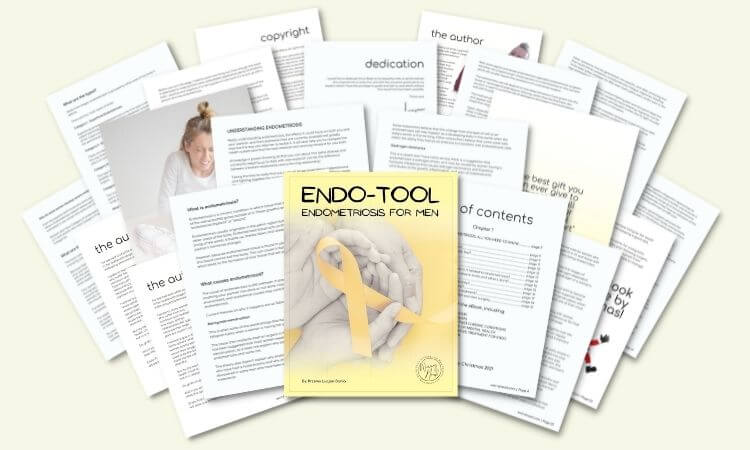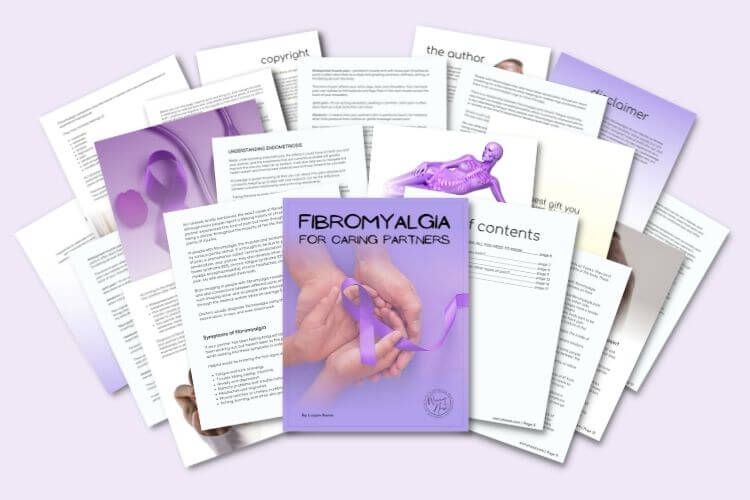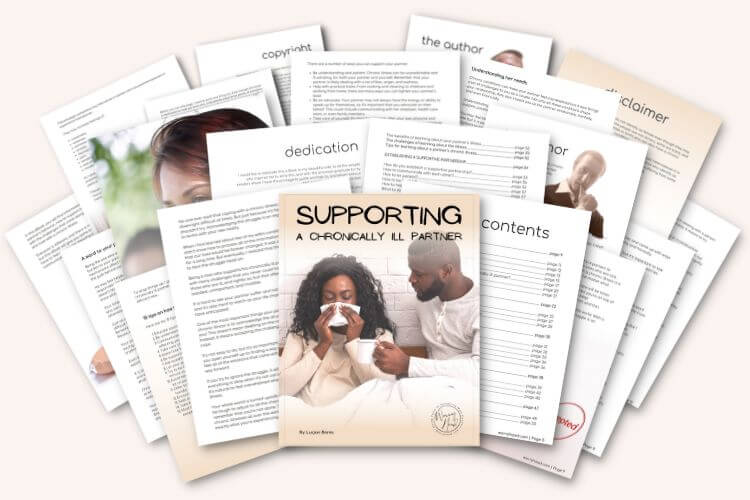How to support your partner with endometriosis and fibromyalgia?
As someone who has seen his wife suffer from endometriosis and fibromyalgia for many years, I understand the emotional and physical toll it can take on both of us. It can be difficult to know how to offer support and comfort when you feel helpless in the face of such chronic and debilitating conditions. That’s why I’ve dedicated my blog to providing resources and information specifically for men who want to learn how to support their partners through these difficult times.
Endometriosis and fibromyalgia are often misunderstood and underdiagnosed conditions, which is why it’s so important for me to raise awareness and provide education. By learning more about these conditions and how they impact the lives of those who suffer from them, we (men) can become better partners and allies in their journey toward healing and relief.
In this article, I will provide practical tips and strategies for supporting your partner with endometriosis and fibromyalgia, from ways to offer emotional support to practical advice for managing daily tasks and responsibilities.
I hope that this information will help you feel more empowered and equipped to be the best possible partner to your loved one, as they navigate the challenges of living with these chronic conditions.
Endometriosis and fibromyalgia are two chronic conditions that can be challenging to manage. If your partner is dealing with one or both, it’s important to offer your support and understanding.
Understanding endometriosis and fibromyalgia.
Before I dive into the ways you can support your partner, I want to take a closer look at what endometriosis and fibromyalgia are and what their symptoms are, separately.
This is important because even though many people who sign up for my email list need information on both – endometriosis and fibromyalgia, there are many who only need information about one of them.
What is endometriosis?
Endometriosis is a chronic condition where tissue that is similar to the lining of the uterus grows outside of it. It’s a medical condition that affects women of reproductive age.
Normally, the tissue that lines the inside of the uterus (called the endometrium) grows and sheds each month during the menstrual cycle. However, for women with endometriosis, a similar tissue (not the same) grows in places it shouldn’t, like outside the uterus in the pelvis, on the ovaries, or even on other organs in the body.
This can cause pain, inflammation, and sometimes infertility.
It’s a chronic condition that can be really tough to live with, but there are treatments available to manage the symptoms and help people with endometriosis live full and happy lives. If you or your partner have any concerns about endometriosis, it’s important to talk to a healthcare provider. Ideally, men should accompany women to their appointments, and this article explains why they should.
Symptoms of endometriosis can include:
- Painful periods
- Pain during sex
- Chronic pelvic pain
- Infertility
- Fatigue
Endometriosis can be difficult to diagnose, taking on average 7 to 8 years, but it is also difficult to treat. Endometriosis can have a significant impact on a person’s quality of life, but also on their romantic partner.
If you want to learn more about endometriosis, I wrote an “Endo-Tool, Endometriosis for Men” e-Book.
You can get the 1st Chapter of the e-Book for FREE, and if you like it, you’ll get a Whopping 33% Discount on the Whole Book, plus discounts on other helpful tools. You have nothing to lose but a lot to gain!
The first chapter alone contains all the comprehensive medical knowledge about endometriosis, including:
- What is endometriosis?
- What are the symptoms?
- What causes endometriosis?
- What does endometriosis look like?
- What are the stages?
- What are the types?
- What is adenomyosis and how is it related to endometriosis?
- Why do some women develop severe endo and others don’t?
- Does endometriosis cause infertility?
- How is endometriosis diagnosed?
- Do types and stages affect the treatment?
- Recurrence of endometriosis after excision surgery.
FREE Chapter of “Endo-Tool”
Endometriosis e-Book for Men

What is fibromyalgia?
Fibromyalgia is a chronic condition that causes widespread pain and tenderness throughout the body. It’s a medical condition that affects people of all ages but is more common in women (80% of women suffer from it as opposed to 20% of men).
The pain associated with fibromyalgia can be debilitating and can greatly affect a person’s quality of life. But in addition to pain, people with fibromyalgia may experience other symptoms like fatigue, difficulty sleeping, headaches, and memory problems. It can also cause a condition called “fibro fog” where it’s difficult to concentrate or remember things.
There is more to the symptoms of fibromyalgia, although not every person will experience them all, to make it a bit clearer to remember, these symptoms are:
- Fatigue.
- Sleep disturbances.
- Headaches.
- Joint stiffness.
- Numbness or tingling in the hands and feet.
- Irritable bowel syndrome (IBS) symptoms, such as diarrhea or constipation.
- Cognitive problems, such as difficulty concentrating and memory problems.
- Anxiety and depression.
- Sensitivity to loud noises or bright lights.
Fibromyalgia is often difficult to diagnose because there isn’t a specific test for it, and symptoms can be similar to other conditions.
It can take months or even years for someone to receive a proper diagnosis, which can be incredibly frustrating for both the person experiencing symptoms and their loved ones. My wife was diagnosed only one year after her diagnosis with her primary condition – stage 4 deep infiltrating endometriosis.
Although there’s no cure for fibromyalgia, there are treatments available that can help manage the symptoms which include medications, therapy, and lifestyle changes like exercise and stress reduction techniques.
If you or your partner have concerns about fibromyalgia, it’s important to talk to a rheumatologist. By supporting your partner through their diagnosis and treatment, you can make a positive impact on their journey to managing fibromyalgia.
If you want to learn more about fibromyalgia, I wrote a “Fibromyalgia for Caring Partners” e-Book.
You can get the 3 First Chapters of the e-Book for FREE, and if you like it, you’ll get a Whopping 33% Discount on the Whole Book, plus discounts on other helpful tools. You have nothing to lose but a lot to gain.
These chapters alone explain how to accept the new normal, and understand fibromyalgia, and its diagnosis. They include:
- The new you.
- The new her.
- The new reality.
- Introduction to fibromyalgia.
- What is fibromyalgia?
- The early days.
- When you first realize something is wrong.
- Spotting the signs that something is wrong.
- Coming to terms with a chronic illness.
- The role of partner in fibromyalgia.
- The process of getting diagnosed.
Get Your 3 FREE Chapters!
Fibromyalgia for Caring Men

How to support your partner with endometriosis and fibromyalgia.
Now that I outlined the basics and you have a better understanding of these conditions, I want to explore some ways that you can support your partner. These are:
- Education about these conditions.
- Support and understanding.
- Practical help.
- Patience and flexibility.
- Taking care of oneself.
- Accompanying her with appointments.
Educate yourself about the conditions.
Educating yourself about your partner’s condition is one of the most compassionate things that you can (and should) do.
It will help you understand what she is going through and make it easier for you to support her. When you take the time to learn about endometriosis and fibromyalgia, you’ll be able to recognize the symptoms and understand the treatments available. You’ll also be better equipped to advocate for your partner when she’s struggling to get the medical care she needs.
Learning about her conditions can also help you understand how the conditions might affect your relationship.
For example, your partner may have to cancel plans or may not be able to be as physically intimate as she used to be. Understanding these limitations can help you be more patient and empathetic with her, instead of feeling hurt or frustrated.
If you’re unsure where to start, I found the best way – simply ask her if she has any resources she recommends or if she has any support groups or organizations she’s involved with. You can also do some research online of your own, or reach out to her doctor for more information. The more you learn, the better you’ll be able to support her through the journey.
Be supportive and understanding.
Living with a chronic condition can be a constant battle for your partner, both physically and emotionally. It is vital that you are always there to support and understand her through the ups and downs.
It can be easy to become frustrated or impatient with the constant changes and unpredictability of her symptoms, but it’s crucial to remember that she has no control over it.
To stay cool can be especially challenging if your partner has Obsessive-Compulsive Disorder. My wife has OCD, and I often feel like I step on eggshells. So be patient and listen to your partner when she needs to vent or share her feelings.
Validate your partner’s experiences and let her know that she is not alone in her struggle.
Show her love and support and offer practical help whenever possible. Small gestures like making meals, doing household chores, or driving her to appointments can go a long way in helping to manage her condition.
I talk about it more in the next paragraph…
Offer her practical help.
Living with endometriosis and fibromyalgia can be exhausting and overwhelming. These conditions can make it difficult for your partner to manage everyday tasks, such as cooking, cleaning, and running errands.
By offering practical help you can be a great source of support to your partner during difficult times.
For instance, you can offer to cook dinner or do the grocery shopping for her. Alternatively, you can help with house chores like cleaning or laundry. I often scrab a bath and shower, all without her asking me for it, which makes it more special.
By taking some of these tasks off your partner’s plate, you can help ease her physical and mental burden, and allow your partner to focus on her health. It’s also important to remember that offering practical help is not a one-time thing. Her condition is ongoing, so continue to offer your help and support whenever she needs it.
Be patient and flexible.
Chronic conditions can be unpredictable, and symptoms can vary from day to day. It’s important to be patient and flexible with your partner. Understand that they may need to cancel plans or take things slower than usual. Offer your support and reassurance and be willing to adjust your plans as needed.
Living with both conditions can be frustrating for both of you.
Symptoms can flare up unexpectedly, leading to changes in plans or limitations in activities. It’s important to be patient and flexible with your partner during these times. Avoid getting angry or frustrated with her when she needs to cancel plans or take things slower than usual.
Instead, offer your support and reassurance, and be willing to adjust your plans as needed. I often take time off work to stay with my wife when she has a really bad day. As I write this, I took two days off for her, as she is emotionally drained with work from home and her flare-ups that prevent her to focus on it.
Being patient and flexible shows her that I understand and care about her well-being, and can help alleviate some of the stress and anxiety that comes with living with her chronic conditions.
Remember, your support and understanding can make a HUGE difference in your partner’s life.
Encourage self-care.
Her situation can be overwhelming and exhausting, and it’s easy to neglect self-care activities, so encourage your partner to prioritize self-care because it is essential for her well-being.
Activities such as exercise, meditation, and rest can help manage symptoms and improve her overall quality of life.
You can offer to join your partner in some of these activities, making it a fun and enjoyable experience. If your partner prefers to do these activities alone, offer to support her in other ways, like taking care of household chores or cooking a healthy meal while she takes some time for herself.
You can also help and find resources to support her self-care, such as local yoga, pilates (my wife’s favorite), or meditation classes. Recommend helpful apps or websites that she can use. Encouraging your partner to take care of herself is one of the best things you can do to support her in managing any chronic condition.
Help with doctor appointments and treatment.
Let’s face it, managing chronic conditions like endometriosis and fibromyalgia often requires frequent medical appointments and treatments.
As a supportive partner, you can offer to accompany your loved one to these appointments and provide emotional support. This can include listening to her concerns, asking questions, and taking notes.
Help your partner keep track of her medication schedule and treatment plans, and offer to help with any necessary tasks such as picking up prescriptions or scheduling appointments. I found that the best way to do it is by using printables!
In the meantime, you can also offer to research treatment options or help your partner find a specialist if needed. Remember to respect your partner’s autonomy and allow to make her own decisions about her health. Your role is to support and empower them in their journey toward managing the situation.

Coping strategies for couples.
Living with chronic conditions can put a strain on any relationship. Below, I outline some coping strategies for couples dealing with endometriosis and fibromyalgia, and then I explain a bit more about them.
These coping strategies for both of you as a couple are:
- Communicate openly and honestly.
- Manage stress and anxiety.
- Seek professional help.
- Find ways to connect and enjoy life together.
- Resources for support.
- Endometriosis and fibromyalgia support groups.
- Online resources and communities.
- Therapy and counseling services.
- Financial assistance and insurance resources.
As a husband to my chronically ill woman, it’s important for me to communicate openly and honestly with my wife about her chronic condition. I need to encourage my wife to share her thoughts and feelings with me, and also be open and honest about my own feelings. This helps us build trust and strengthen our relationship. I am pleased to say that endometriosis and fibromyalgia did not divide us, they actually strengthened our marriage.
I help my wife manage stress and anxiety by offering support and encouragement. I encourage her to practice stress-reducing activities such as meditation, breathing exercises, and mindfulness. I can also offer to participate in these activities with her to show my support.
If your partner or you are struggling to cope with these chronic conditions, it’s important to seek professional help. You can encourage your partner to consider therapy or counseling, and you can also seek help for yourself if needed.
Finding ways to connect and enjoy life together is important for both of us as a couple. Even though my wife has multiple chronic conditions, it doesn’t mean we can’t have fun and enjoy life. We can look for simple activities such as watching a movie or going for a walk in the woods nearby and make the most of the time we have together.
My wife tried to commit suicide on a few occasions and the time spent together makes it even more special as I never know how she is going to feel.
There are also many resources available for support, including endometriosis and fibromyalgia support groups, online resources and communities, therapy and counseling services, and financial assistance and insurance resources. You can help your partner research and access these resources to make her journey easier.
Overall, supporting someone with chronic conditions can be challenging, but by being open, supportive, and proactive, you can both navigate this journey together.
Conclusion on how to support your partner with endometriosis and fibromyalgia.
Living with chronic conditions such as endometriosis and fibromyalgia can be extremely challenging for both of you in your relationship. It is not always about the ill person. We, blokes, suffer too.
However, with the right strategies and support, you can navigate these challenges together.
It’s essential to communicate openly and honestly, manage stress and anxiety, seek professional help when necessary, find ways to connect and enjoy life together, and access available resources for support.
From joining support groups to seeking therapy, there are many resources available to help couples like you cope with chronic conditions. By working together and supporting each other, you can build a stronger, more resilient relationship, even in the face of chronic illness.
I hope this helps!
In the meantime, if you want more in-depth information about how to support your partner with her chronic conditions and how to cope with the new normal in your relationship, I wrote a “Supporting a Chronically Ill Partner” e-Book.
You can get the 1st Chapter of the e-Book for FREE, and if you like it, you’ll get a Whopping 33% Discount on the Whole Book, plus discounts on other helpful tools. You have nothing to lose but a lot to gain!
The first chapter alone contains a lot of information for both of you about acknowledging the struggles, including:
- A word to your partner.
- A word to you.
- Stepping on eggshells.
- Understanding her needs.
- How to acknowledge having a chronically ill partner?
- Acknowledging can be hard.
- 15 tips on how to do it!
Get the 1st Chapter FREE!
Chronic Illness for Partners



About Me
Hi, I’m Lucjan! The reason why I decided to create this blog was my beautiful wife, who experienced a lot of pain in life, but also the lack of information about endometriosis and fibromyalgia for men...
